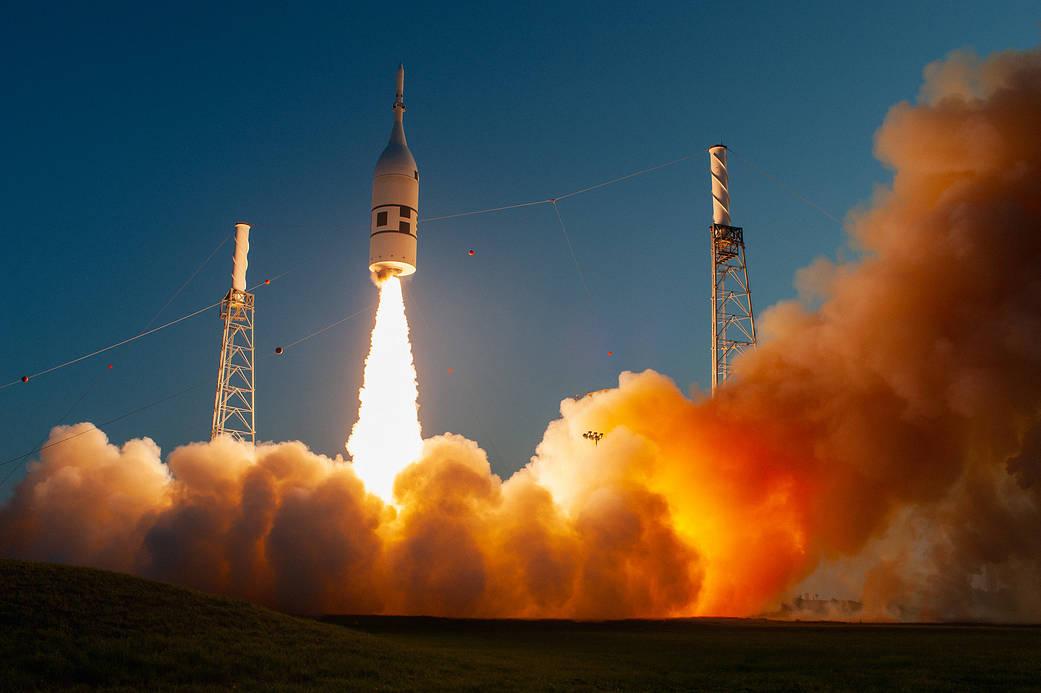
A launch abort system with a test version of Orion in 2019.
The future of access to space may lie with equatorial launch sites that could make launch windows a thing of the past, according to a Feb. 15 Future In Space Operations (FISO) webinar.
Low-altitude equatorial orbits could be a first or final step in carrying out missions for uses including national security, solar power generation, human space resorts, dry docks for assembling large space assets, or even staging space lasers as light sail propulsion sources.
“What I’m proposing is pretty radical even for me,” Rand Simberg, president of Interglobal Media, LLC, told the FISO audience in a webinar entitled, “Equatorial Low Earth Orbit (ELEO): Earth’s Natural Harbor.”
The potential benefits of ELEO include taking full propulsive advantage of the Earth’s rotation for space launches, eliminating launch window constraints governed by specific orbital inclination mission destinations and placing payloads in ELEO. Once in ELEO, they could hook up with “harbor tugs” to continue their journeys to geosynchronous destinations, or turn to an electric propulsion source to reach higher altitude or an ELEO laser for light sail propulsion to higher-inclination orbits.
Other benefits include an option for concentrating as much space activity as possible in a single orbit plane with low relative velocities to simplify space traffic management; relying on the low altitude that could facilitate the disposal of space debris at a faster pace; easier planning for missions to cislunar space and beyond; posing lower risk to populated land masses when launching nuclear reactors for deep-space mission propulsion; and minimizing pollution in the upper atmosphere.
“Basically, what we are talking about is if you have regularly scheduled flights every day into ELEO, you could do that because there are no launch windows,” Simberg said. “You can think of it as a traditional launch rate with a payload on a rocket. But think of it as a mass pipeline to space. It would open up the space frontier in the same way the transcontinental railroad opened up the West.”
While touting his ELEO vision, Simberg noted the current absence of equatorial launch sites across the globe—with the exception of the European Spaceport located in Kourou, French Guiana, just 500 km (312 mi.) north of the equator. “Close, but still a pretty big dogleg,” Simberg said.
He pointed to SpaceX and its Starship, which includes a reusable Super Heavy first stage and Starship upper stage, as offering perhaps the nearest-term potential for ELEO launch operations.
But SpaceX recently sold a pair of deep-water oil rigs it planned to convert to floating launch platforms that could have provided equatorial launch site potential. Simberg and his FISO audience noted that SpaceX President and Chief Operating Officer Gwynne Shotwell has said neither of the rigs was assessed as suitable for Starship and the company would wait on further pursuit of a floating launch platform candidate until it has flight tested Starship.
As the presentation was ending, the FISO gathering noted that Orlando, Florida-based startup Vicillion announced earlier in the week that it is seeking investors and partners to pioneer the development and operations of a multiuser, commercial equatorial spaceport to support future space tourism, asteroid mining and human exploration beyond Earth orbit.
As the ELEO concept matures, it could face opposition on a couple of major fronts, though Simberg predicts the economic and operational promise should win the day.
The space industry that has grown up around Cape Canaveral and Vandenberg, California, over the years can continue to thrive economically without launching rockets, Simberg says, noting the strength of aerospace industry activities in locales such as Seattle, Denver and Houston that do not include rocket launches.
In the case of SpaceX, the company’s Starship could self-transport to equatorial launch sites once the large rocket is assembled at facilities in Boca Chica, Texas, and Cape Canaveral, Simberg noted.
“People there just have to get used to the idea, we are not going to launch from ‘here’ anymore,” Simberg said.
If ELEO thrives as he predicts, Simberg cautioned its high economic value would make it a target for terrorists.
“To me, the only solution is to have a very, very active defense that doesn’t allow anyone to launch into a retrograde equatorial orbit. But it’s not that hard,” he predicted. “With [current] missile defenses you have to cover the whole globe and hope your interceptor is in the right place at the right time. But if everything is in ELEO, you can continually monitor it. You will see launches coming up, and you can take them out from space before they can get to where they want to go.”
